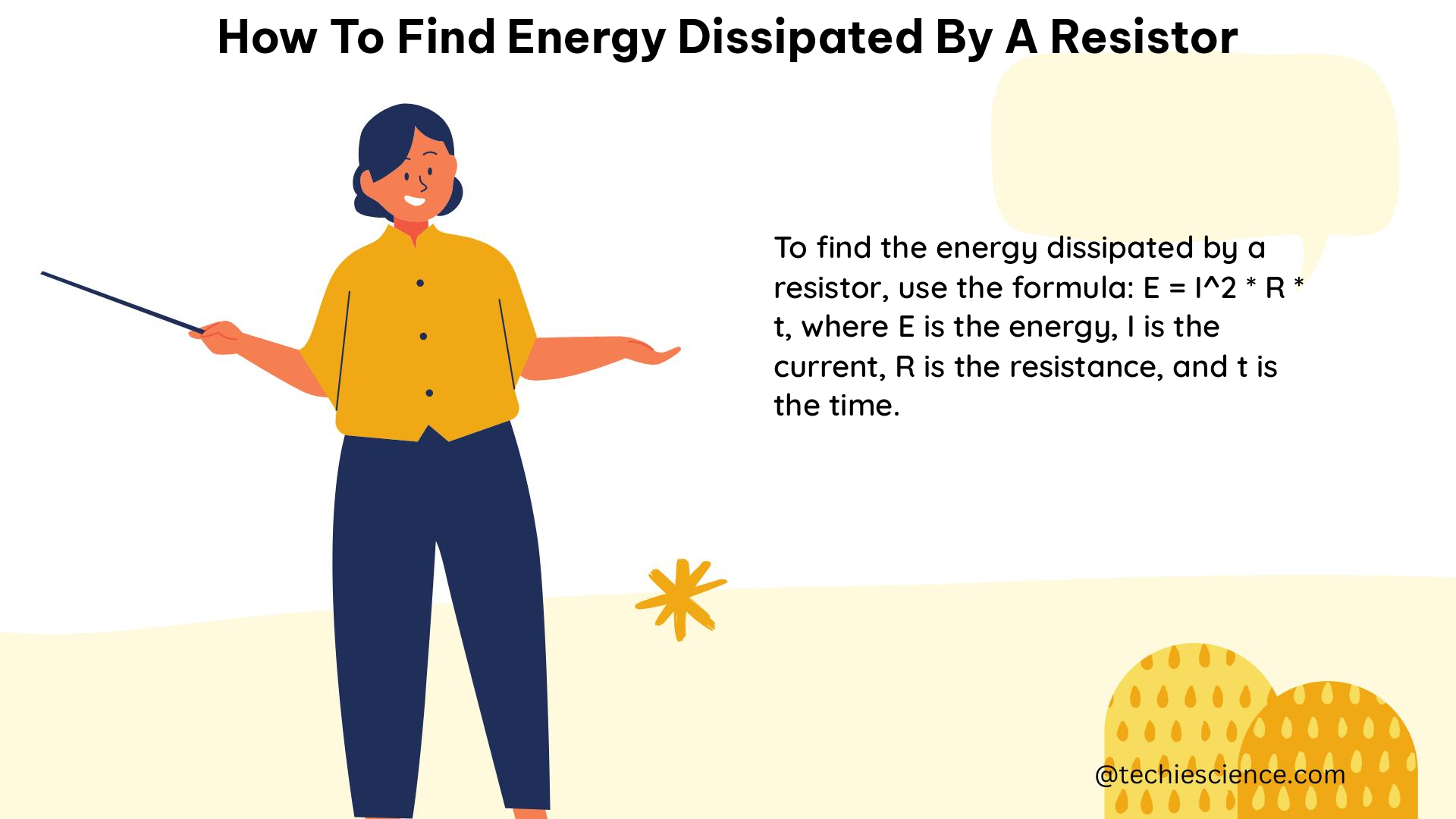Summary
Calculating the energy dissipated by a resistor is a fundamental concept in electrical engineering and physics. This comprehensive guide will provide you with the necessary formulas, technical specifications, examples, and problem-solving techniques to accurately determine the energy dissipated by a resistor in various circuit configurations.
Understanding Electrical Power and Energy Dissipation

The power dissipated by a resistor is the rate at which energy is transferred or converted into heat within the resistor. This power can be calculated using the following formula:
P = I^2 * R = V^2 / R = I * V
where:
– P is the power in watts (W)
– I is the current in amperes (A)
– V is the voltage in volts (V)
– R is the resistance in ohms (Ω)
The energy dissipated by a resistor over a given time period can be calculated using the formula:
E = P * t
where:
– E is the energy in joules (J)
– P is the power in watts (W)
– t is the time in seconds (s)
Ohm’s Law and Power Calculations
Ohm’s Law is a fundamental principle in electrical circuits that relates the voltage, current, and resistance. It can be expressed in the following forms:
V = I * R
I = V / R
R = V / I
By substituting these Ohm’s Law relationships into the power formula, we can express the power dissipated by a resistor in terms of either current and resistance, or voltage and resistance:
P = I^2 * R
P = V^2 / R
These formulas are essential for calculating the power dissipated by a resistor in various circuit configurations.
Examples and Problem-Solving Techniques
Let’s explore some examples to illustrate how to calculate the energy dissipated by a resistor.
Example 1: Power Dissipation with Known Current and Resistance
What is the power dissipated through a resistor with a resistance of 10 ohms and a current of 2 amperes?
Using the formula P = I^2 * R, we can calculate the power as:
P = (2 A)^2 * 10 Ω = 40 W
Therefore, the resistor is dissipating 40 watts of energy.
Example 2: Power Dissipation with Known Voltage and Resistance
What is the power dissipated through a resistor with a resistance of 50 ohms and a voltage of 10 volts?
Using the formula P = V^2 / R, we can calculate the power as:
P = (10 V)^2 / 50 Ω = 2 W
Therefore, the resistor is dissipating 2 watts of energy.
Example 3: Energy Dissipation with Known Power Rating, Resistance, and Time
What is the energy dissipated by a resistor with a power rating of 10 watts and a resistance of 100 ohms if a current of 0.1 amperes is flowing through it for 10 seconds?
Using the formula E = P * t, we can calculate the energy as:
E = (10 W) * (0.1 A)^2 * 100 Ω * 10 s = 10 J
Therefore, the resistor is dissipating 10 joules of energy.
Resistor Power Rating and Thermal Considerations
The power rating of a resistor is the maximum power that it can dissipate without overheating or failing. This power rating is typically specified in watts and depends on the physical size and material of the resistor.
When selecting a resistor for a circuit, it is crucial to choose one with a power rating that is equal to or greater than the calculated power dissipation. Using a resistor with a power rating that is too low can cause it to overheat and fail, potentially damaging the circuit or even causing a fire.
Additionally, it is important to consider the thermal characteristics of the resistor, such as its temperature coefficient of resistance and thermal resistance. These factors can affect the resistor’s performance and reliability in high-power applications.
Conclusion
In this comprehensive guide, we have explored the fundamental concepts and formulas for calculating the energy dissipated by a resistor. By understanding Ohm’s Law, the power formula, and the energy equation, you can accurately determine the energy dissipation in various circuit configurations.
Remember to always consider the power rating and thermal characteristics of the resistor when designing or analyzing electrical circuits to ensure safe and reliable operation.
References
- How to Calculate the Power Dissipated through a Resistor from the Voltage and Resistance: https://study.com/skill/learn/how-to-calculate-the-power-dissipated-through-a-resistor-from-the-voltage-resistance-explanation.html
- Calculating Power Dissipation for Short Periods of Time: https://forum.allaboutcircuits.com/threads/calculating-power-dissipation-for-short-periods-of-time.121584/
- Energy Dissipated by a Resistor – YouTube: https://www.youtube.com/watch?v=_YbsWk-QJLI

The lambdageeks.com Core SME Team is a group of experienced subject matter experts from diverse scientific and technical fields including Physics, Chemistry, Technology,Electronics & Electrical Engineering, Automotive, Mechanical Engineering. Our team collaborates to create high-quality, well-researched articles on a wide range of science and technology topics for the lambdageeks.com website.
All Our Senior SME are having more than 7 Years of experience in the respective fields . They are either Working Industry Professionals or assocaited With different Universities. Refer Our Authors Page to get to know About our Core SMEs.